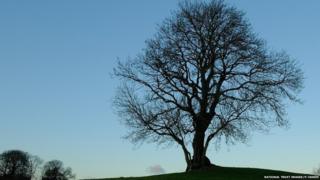
Image copyright
National Trust Images/P.Tasker
The National Trust has said it has experienced the worst year on record for ash dieback on its estates.
It says a combination of the coronavirus lockdown and the driest spring on record created a “perfect storm” for the disease to spread.
The charity says it will have to spend £2m on felling infected trees this year – four times more than the average cost of felling trees.
Sites affected are places that inspired Beatrix Potter and John Constable.
“Ash dieback is a catastrophe for nature,” said the trust’s national tree and woodland adviser, Luke Barley.
“Our landscapes and woodlands are irrevocably changing before our eyes, and this year’s combination of a dry spring and late frost may have dramatically sped up the severity of ash dieback.”
Lockdown impacts
Mr Barley went on to explain that the charity’s estates across the country were being hit hard by the pathogen.
From author Beatrix Potter’s Troutbeck Farm in the Lake District to the trees around John Constable’s hometown of Flatford, Suffolk – which is said to have provided the inspiration for his masterpiece, the Hay Wain – all were feeling the impact of the disease spread going largely unchecked over the past six months.
“Lockdown has meant we were not able to undertake regular conservation work and many of our rangers who have returned are now forced to spend time felling to manage safety,” Mr Barley added.
“Vital conservation work, such as tree planting, managing flower-rich meadows and important maintenance work is having to go on hold as a result.”
Ash dieback, triggered by a fungus called Hymenoscyphus fraxineus, causes dieback of leaves and branches by shutting down tubes in the trunk that the trees use to transport water and nutrients through its woody frame.
Although the disease, originally from eastern Asia, has been present in mainland Europe for a number of decades, it arrived in the UK back in 2012.
In less than a decade, it has spread to all parts of Britain and affected hundreds of thousands of ash trees, if not millions.
Ash trees are one of the UK’s most abundant tree species, and studies suggest the dieback disease is going to cost the UK economy billions of pounds.
The UK government has recently held a public consultation on its forthcoming tree strategy, which includes ways to increase the resilience and biosecurity of the nation’s trees.
Earlier this year, the National Trust announced that it was going to have to finding savings of £100m each year as a result of the lost income from the coronavirus lockdown.
Yet the cost of the felling of diseased ash is set to cost millions of pounds, the charity said.
In a normal year, rangers would expect to fell between 4,000 and 5,000 trees on the trust’s land. However, it expects to have to cut down an estimated 40,000 trees this year.
In order to help cover the additional costs, the National Trust is asking for donations from the public.
Read MoreFeedzy


